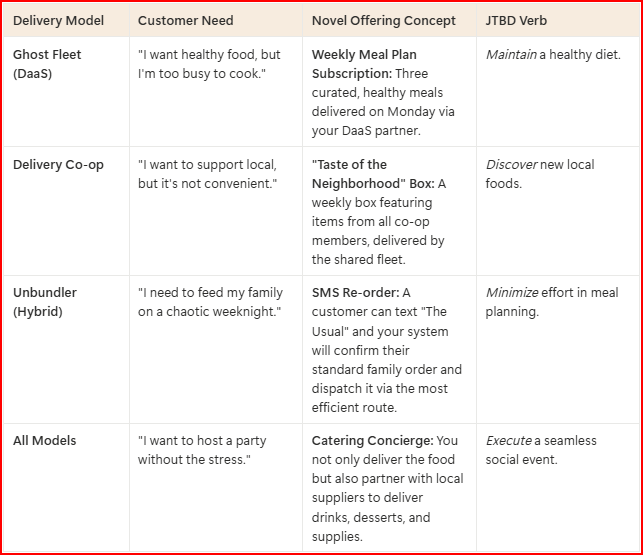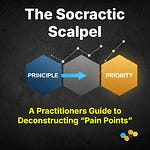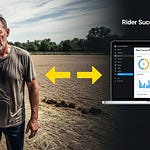Table of Contents
Introduction: You Won the Customer. Now Win the Last Mile.
First-Principles Deconstruction: The Job of “Getting Food Delivered”
The Three Paths to Delivery Independence
Playbook 1: The ‘Ghost Fleet’ - Leveraging Delivery-as-a-Service (DaaS)
Playbook 2: The Delivery Co-op - Strength in Numbers
Playbook 3: The Unbundler - Building a Hybrid Logistics Engine
The Moat is the Model: Using Doblin’s 10 Types to Defend Your Business
The Future: From Delivering Meals to Managing Home-Food Logistics
Conclusion: Your Restaurant is Now a Logistics Company
This is a follow-up post to the Parasite Strategy for restauranteurs. While I touched on this very briefly, I did get an inquiry about how to deal with the obvious gap … the delivery expectation. You can read the original article here 👇.
Introduction: You Won the Customer. Now Win the Last Mile.
So, you did it. You turned the tables. You saw the delivery apps for what they are: a marketing funnel with a punishing 30% tax. You built your Trojan Horse, slipped it into every delivery bag, and started pulling customers away from the apps and into your own world. Your direct orders are climbing, you’re keeping more of your hard-earned money, and for the first time in a long time, you actually know who your customers are.
Congratulations. You’ve just solved a massive problem. And in doing so, you’ve created a brand new one.
A customer you acquired from DoorDash still expects the convenience of delivery. They don’t want to give that up. The problem is, you fired DoorDash. Now what? You have a direct relationship, a direct order, and a customer on their couch who’s wondering when their food will arrive.
This is a high-quality problem. It’s the kind of challenge you want to have. It means you’ve won the first, most important battle: the battle for the customer relationship. But now you have to win the second: the battle for the last mile.
The knee-jerk reaction is to think you have two bad options: hire your own fleet of drivers (which is a costly, operational nightmare) or give up and go back to the apps. That’s a false choice. The truth is, you’re no longer just a restaurant. You’re a direct-to-consumer business. And that means you have to start thinking like a logistics company.
This guide is your playbook for that new reality. We’re going to break down the problem of delivery from first principles and then explore three powerful, practical strategies for building your own profitable, independent delivery system. You’ve already done the hard part. Now it’s time to build the machine that makes it all work.
First-Principles Deconstruction: The Job of “Getting Food Delivered”
Before you can build a solution, you have to fundamentally understand the problem you’re trying to solve. When a customer orders delivery, what “job” are they really hiring your restaurant to do? If you rely on conventional wisdom, you’ll end up with a list of assumptions that will lead you astray. Let’s deconstruct them.
Assumption 1: “I need to hire full-time drivers.”
This is the biggest mental block for most restaurant owners. You think of “delivery” and you picture an employee in a branded t-shirt, sitting in the back, waiting for an order. That’s a massive, inefficient cost.
Refutation: You don’t need to employ drivers. You need access to delivery capacity at the exact moment an order is ready. The ownership model of that capacity—whether it’s a W2 employee, a freelancer, a partner, or a co-op member—is completely irrelevant as long as the job gets done reliably and professionally.
Assumption 2: “Delivery has to be a loss-leader.”
The apps have trained us to think that “free delivery” is the only way to compete, forcing us to eat the cost. We associate delivery with the 30% commission, so we assume the entire enterprise is unprofitable.
Refutation: When you unbundle the 30% commission from the actual, physical cost of moving a bag from your kitchen to a customer’s door, the numbers change dramatically. The true cost of a single delivery is far less than 30% of the order value. This gives you room to price it transparently, offer it as a premium service, or bundle it into a loyalty program in a way that is both fair to the customer and profitable for you.
Assumption 3: “I can’t compete with the speed of the big apps.”
You see the massive driver networks of Uber Eats and DoorDash and think it’s impossible to match their delivery times.
Refutation: You shouldn’t try to. You’re not competing on a few minutes of speed; you’re competing on the overall experience. A customer will happily wait an extra 5-10 minutes for food that arrives hotter, is packaged better, and comes from a restaurant they have a real relationship with. Your competitive advantage isn’t raw speed; it’s quality, reliability, and communication—things the apps are notoriously bad at.
With those assumptions stripped away, we can establish a new foundation built on core truths.
The New Foundation (Core Truths):
The Job is Package-Moving: At its core, delivery is a logistics problem. You need to move a package (the food) from Point A (your kitchen) to Point B (the customer) within a specific timeframe while maintaining the package’s integrity (temperature, presentation). That’s it.
Data is the Real Asset: The most valuable thing you get from a direct order isn’t the profit margin; it’s the customer’s data and the direct line of communication. Your delivery system must be designed to protect and enhance this asset.
Efficiency Comes From Utilization: The key to profitable logistics is “asset utilization.” For the apps, that means keeping a driver’s car full and moving. For you, it means finding a model that maximizes the efficiency of your chosen delivery capacity, ensuring you’re only paying for it when you need it.
Armed with these first principles, you’re no longer trying to build a miniature DoorDash. You’re trying to solve a much simpler, more focused problem: getting a package from A to B, reliably and profitably. And for that, there are far better tools for the job.
The Three Paths to Delivery Independence
Now that we’ve cleared away the assumptions and defined the real job to be done, we can explore the strategic paths forward. There isn’t a single “best” way to build your delivery system; the right choice for you will depend on your location, your order volume, and your appetite for collaboration. We’ll cover three powerful models: The ‘Ghost Fleet’, The Delivery Co-op, and The Unbundler.
Playbook 1: The ‘Ghost Fleet’ - Leveraging Delivery-as-a-Service (DaaS)
The simplest and fastest way to get started with self-delivery is to not do it yourself at all. Instead, you can tap into a “Ghost Fleet” of on-demand, white-label couriers who work for you, not for a big tech app.
This is the tech play. It’s for the operator who wants a scalable, low-overhead solution that feels like magic to the customer.
How it Works:
Delivery-as-a-Service (DaaS) platforms are the secret weapon here. Think of them as the plumbing for the delivery world. Companies like Nash, Vromo, or Relay provide the software and the network of drivers; you just provide the orders.
When a customer places a direct order on your website, your system sends an API call to the DaaS platform. It instantly finds the nearest available courier, dispatches them to your restaurant, and gives you and your customer full tracking capabilities. To your customer, it looks like you have a sophisticated delivery network. In reality, you’re just plugging into one.
Pros:
Zero Capital Expenditure: You don’t have to hire drivers, buy vehicles, or pay for insurance. You pay a flat fee per delivery, which you can easily bake into your pricing.
Infinitely Scalable: Whether you have 5 orders a night or 50, the network can handle it. You never have to worry about being short-staffed on a busy Friday.
Focus on Your Food: You get all the benefits of delivery without any of the operational headaches. This lets you focus on what you do best: making great food.
Cons:
Less Brand Control: You have less direct control over the driver’s training and the at-the-door customer experience compared to having your own employee.
Variable Pricing: While cheaper than the big apps, DaaS fees can fluctuate, and you’re still reliant on a third-party for a core part of your service.
Implementation Checklist:
Research Partners: Look for DaaS providers that operate in your area and integrate with your specific POS or online ordering system (like Shopify, Olo, or GloriaFood).
Analyze Your Data: Calculate your average delivery distance and order value to understand the per-delivery fee. Make sure the unit economics work.
Brand the Experience: Even though you don’t control the driver, you control the communication. Use the tracking links and notifications to reinforce your brand, not the DaaS provider’s.
Playbook 2: The Delivery Co-op - Strength in Numbers
What if, instead of renting access to a network, you built one with your neighbors? The Delivery Co-op is the community play. It’s for the restaurateur who believes that a rising tide lifts all boats and is willing to collaborate to solve a shared problem.
How it Works:
You team up with 3-5 other non-competing restaurants in your neighborhood—a pizzeria, a Thai place, a salad shop, a bakery. Together, you form a new entity, a delivery co-operative. This co-op jointly hires a small team of drivers and invests in a shared fleet of vehicles (often cost-effective e-bikes or scooters for dense areas).
A central dispatch system, which can be as simple as a shared software or even a dedicated part-time employee, manages the orders from all participating restaurants. The drivers are no longer sitting around waiting for one restaurant’s orders; they are constantly making runs for the entire co-op, maximizing their efficiency.
Pros:
Shared Costs, Better Economics: Splitting the cost of wages, insurance, and vehicles five ways makes an in-house fleet dramatically more affordable.
Full Control: These are your drivers. You control the training, the uniform, and the customer experience. They are ambassadors for your brand and the co-op’s.
Builds a Powerful Local Moat: A successful co-op doesn’t just solve delivery; it creates a powerful local alliance that can collaborate on marketing, purchasing, and more, making it very difficult for outsiders to compete.
Cons:
High Coordination Required: This model requires a huge amount of trust and communication between business owners. You’ll need clear legal agreements and operational rules from day one.
More Complex Setup: You’re essentially starting a small logistics company. There are legal, financial, and operational hurdles to overcome before you can make your first delivery.
Implementation Guide:
Find Your Allies: Identify other successful, non-competitive restaurant owners in your delivery radius who you trust.
Start the Conversation: Frame it as a shared problem. Bring data on how much you’re all collectively paying to the big apps.
Structure the Deal: Work with a lawyer to create an operating agreement for a new LLC that you all co-own. Clearly define ownership, costs, and operational responsibilities.
Start Small: Begin with one or two shared drivers during peak hours and scale from there.
Playbook 3: The Unbundler - Building a Hybrid Logistics Engine
This is the most advanced play, for the high-volume, data-savvy operator. The Unbundler doesn’t choose one solution; they use the best tool for every specific job. They look at the delivery apps and don’t see a single service; they see a bundle of functions—marketing, ordering, and logistics—and they systematically find a better, cheaper replacement for each.
How it Works:
The Unbundler creates an internal logic system that routes every single delivery order based on a set of pre-defined rules. They build a hybrid model that blends the best of in-house capabilities with the scale of DaaS platforms.
An Example Model:
Rule 1 (Hyper-Local): If an order is within a 1-mile radius, dispatch an in-house employee on a restaurant-owned e-bike. This is the cheapest, fastest, and most brand-controlled delivery possible.
Rule 2 (Standard Delivery): If an order is between 1-5 miles, automatically dispatch it to your preferred ‘Ghost Fleet’ (DaaS) partner.
Rule 3 (Catering/Large Order): If an order is over a certain dollar amount, flag it for a special delivery protocol, perhaps using a dedicated in-house vehicle or a premium courier service.
Pros:
Fully Optimized for Cost: You are always using the most cost-effective delivery method for every single order, maximizing your profit.
Incredible Flexibility: You can adjust your rules on the fly based on weather, demand, or time of day. You get the control of an in-house system with the scale of a DaaS network.
Ultimate Resilience: You aren’t reliant on any single provider. If your DaaS partner has a surge in pricing, you can lean more on your in-house team, and vice-versa.
Cons:
Requires Tech and Management: You need an online ordering system with a robust rules-based engine and someone who can manage and analyze the data to continually optimize the system.
More Moving Parts: This isn’t a “set it and forget it” model. It requires active management to ensure everything is running smoothly.
Implementation Guide:
Analyze Your Order Data: Map out where your orders come from. What percentage are within 1 mile? 3 miles? 5 miles? This will tell you what your “zones” should be.
Choose Your Tools: Invest in an online ordering system that allows for custom delivery zones and routing rules.
Start with One Rule: Begin by carving out a hyper-local zone for in-house delivery. Perfect that process first, then add the DaaS integration for longer-range orders.
The Moat is the Model: Using Doblin’s 10 Types to Defend Your Business
Choosing one of these playbooks isn’t just an operational decision; it’s a strategic one. You’re not just moving food; you’re building a competitive moat that the big apps, with their one-size-fits-all model, can’t cross.
The most resilient businesses are built by innovating in more than one area. Let’s look at how these delivery models, when combined with the “Trojan Horse” funnel you’ve already built, stack up using the Doblin’s 10 Types of Innovation framework.
You started by innovating your Process (the Trojan Horse funnel) and your Customer Engagement (building a direct relationship). Now, by adding a new delivery model, you’re stacking innovations on top of each other, making your business incredibly hard to copy.
The Ghost Fleet (DaaS) Model: This is a Process innovation. You’re creating a more efficient, cost-effective backend system for fulfillment. When paired with your direct customer relationship, you have a lean, scalable business model that can outmaneuver more bloated competitors.
The Delivery Co-op Model: This is a powerful Network and Business Model innovation. You’re creating value by connecting with other businesses in a way your competitors aren’t. This alliance builds shared strength and creates a local, collaborative brand that customers can feel good about supporting.
The Unbundler (Hybrid) Model: This is a Profit Model innovation at its finest. By meticulously optimizing the cost of every single delivery, you are designing a system that is fundamentally more profitable than any of your rivals, including the big apps themselves.
When you combine any of these logistics models (Process, Network, Profit Model) with your superior food (Product Performance) and your direct customer list (Customer Engagement), you’ve created a multi-layered moat. A competitor can’t just copy one thing; they have to copy the entire, interconnected system.
The Future: From Delivering Meals to Managing Home-Food Logistics
Mastering your own delivery doesn’t just solve a problem you have today; it opens up entirely new possibilities for what your restaurant can become tomorrow. You’re no longer just a place people come to eat; you’re a logistics hub for your local community.
This is where you can truly elevate the level of abstraction. The job of “getting a meal delivered” is just the beginning. What’s the bigger, higher-context job your customers need done? It’s probably something like “effortlessly manage my household’s food needs for the week.”
Owning your delivery network gives you the platform to solve that job in ways you never could before.
Concepts You Can Implement Today:
Batch Delivery for Meal Kits: Your new delivery system is perfectly suited to deliver meal kits or pre-prepped family meals on a specific day of the week, creating a new, recurring revenue stream.
Local Pantry Partnerships: Team up with a local bakery, coffee roaster, or butcher. Since you already have the delivery infrastructure, you can offer to deliver their products along with your food for a small fee, creating another revenue stream and providing more value to your customers.
Novel Concepts for Tomorrow:
The Subscription Box: What if a customer could subscribe to your restaurant? For a monthly fee, they get a certain number of meals delivered, plus exclusive access to new menu items or a “pantry stock” of your signature sauces and spices. You get predictable, recurring revenue.
The Neighborhood Hub: Your restaurant could become the central logistics point for your entire block. You could manage deliveries for multiple local businesses, creating a co-op that goes far beyond just restaurants.
To help spark some ideas, here is a creativity matrix. The goal is to combine a Delivery Model with a Customer Need to create a Novel Offering.
Conclusion: Your Restaurant is Now a Logistics Company
The journey started with a simple goal: take back your customers from the delivery apps. But in solving that problem, you’ve unlocked a far greater opportunity.
The future of the independent restaurant industry won’t be defined by who has the best food alone. It will be defined by those who master the entire system, from customer acquisition to final delivery. By taking control of your own logistics, you’re not just saving money on commissions; you’re taking control of your destiny.
You’ve won the customer. You’ve built the funnel. Now, by building your own delivery engine—whether through smart tech, community collaboration, or hybrid optimization—you can win the last mile. You’re no longer just a restaurant owner. You’re the founder of a modern, resilient, direct-to-consumer brand. You’re a logistics company that just happens to make amazing food.
Follow me on 𝕏: https://x.com/mikeboysen
If you’re interested in inventing the future as opposed to fiddling around the edges, feel free to contact me. My availability is limited.
Mike Boysen - www.pjtbd.com
De-Risk Your Next Big Idea
Masterclass: Heavily Discounted $67
My Blog: https://jtbd.one
Book an appointment: https://pjtbd.com/book-mike
Join our community: https://pjtbd.com/join












